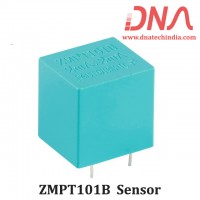The PNP Transistor |
||||||||||||||||||||||||||||
|
The PNP Transistor is the exact opposite to the NPN Transistor device we looked at in the previous tutorial. Basically, in this type of transistor construction the two diodes are reversed with respect to the NPN type giving a Positive-Negative-Positive configuration, with the arrow which also defines the Emitter terminal this time pointing inwards in the transistor symbol. |
||||||||||||||||||||||||||||
|
Also, all the polarities for a PNP transistor are reversed which means that it "sinks" current as opposed to the NPN transistor which "sources" current. The main difference between the two types of transistors is that holes are the more important carriers for PNP transistors, whereas electrons are the important carriers for NPN transistors. Then, PNP transistors use a small output base current and a negative base voltage to control a much larger emitter-collector current. The construction of a PNP transistor consists of two P-type semiconductor materials either side of the N-type material as shown below. |
||||||||||||||||||||||||||||
|
|
||||||||||||||||||||||||||||
A PNP Transistor Configuration |
||||||||||||||||||||||||||||
|
|
||||||||||||||||||||||||||||
| (Note: Arrow defines the emitter and conventional current flow, "in" for a PNP transistor.) | ||||||||||||||||||||||||||||
|
The construction and terminal voltages for an NPN transistor are shown above. The PNP Transistor has very similar characteristics to their NPN bipolar cousins, except that the polarities (or biasing) of the current and voltage directions are reversed for any one of the possible three configurations looked at in the first tutorial, Common Base, Common Emitter and Common Collector. |
||||||||||||||||||||||||||||
The voltage between the Base and Emitter ( VBE ), is now negative at the Base and positive at the Emitter because for a PNP transistor, the Base terminal is always biased negative with respect to the Emitter. Also the Emitter supply voltage is positive with respect to the Collector ( VCE ). So for a PNP transistor to conduct the Emitter is always more positive with respect to both the Base and the Collector. The voltage sources are connected to a PNP transistor are as shown. This time the Emitter is connected to the supply voltage VCC with the load resistor, RL which limits the maximum current flowing through the device connected to the Collector terminal. The Base voltage VB which is biased negative with respect to the Emitter and is connected to the Base resistor RB, which again is used to limit the maximum Base current. |
||||||||||||||||||||||||||||
|
To cause the Base current to flow in a PNP transistor the Base needs to be more negative than the Emitter (current must leave the base) by approx 0.7 volts for a silicon device or 0.3 volts for a germanium device with the formulas used to calculate the Base resistor, Base current or Collector current are the same as those used for an equivalent NPN transistor and is given as. |
||||||||||||||||||||||||||||
|
|
||||||||||||||||||||||||||||
| Generally, the PNP transistor can replace NPN transistors in most electronic circuits, the only difference is the polarities of the voltages, and the directions of the current flow. PNP transistors can also be used as switching devices and an example of a PNP transistor switch is shown below | ||||||||||||||||||||||||||||
|
|
||||||||||||||||||||||||||||
A PNP Transistor Circuit |
||||||||||||||||||||||||||||
|
|
||||||||||||||||||||||||||||
|
The Output Characteristics Curves for a PNP transistor look very similar to those for an equivalent NPN transistor except that they are rotated by 180o to take account of the reverse polarity voltages and currents, (the currents flowing out of the Base and Collector in a PNP transistor are negative). The same dynamic load line can be drawn onto the I-V curves to find the PNP transistors operating points. |
||||||||||||||||||||||||||||
|
|
||||||||||||||||||||||||||||
Transistor Matching |
||||||||||||||||||||||||||||
You may think what is the point of having a PNP Transistor, when there are plenty of NPN Transistors available that can be used as an amplifier or solid-state switch?. Well, having two different types of transistors "PNP" and "NPN", can be a great advantage when designing amplifier circuits such as the Class B Amplifier which uses "Complementary" or "Matched Pair" transistors in its output stage or in reversible H-Bridge motor control circuits were we want to control the flow of current evenly in both directions.
A pair of corresponding NPN and PNP transistors with near identical characteristics to each other are called Complementary Transistors for example, a TIP3055 (NPN transistor) and the TIP2955 (PNP transistor) are good examples of complementary or matched pair silicon power transistors. They both have a DC current gain, Beta, ( Ic/Ib ) matched to within 10% and high Collector current of about 15A making them ideal for general motor control or robotic applications. |
||||||||||||||||||||||||||||
|
Also, class B amplifiers use complementary NPN and PNP in their power output stage design. The NPN transistor conducts for only the positive half of the signal while the PNP transistor conducts for negative half of the signal. This allows the amplifier to drive the required power through the load loudspeaker in both directions at the stated nominal impedance and power resulting in an output current which is likely to be in the order of several amps shared evenly between the two complementary transistors. |
||||||||||||||||||||||||||||
|
|
||||||||||||||||||||||||||||
Identifying the PNP Transistor |
||||||||||||||||||||||||||||
|
We saw in the first tutorial of this transistors section, that transistors are basically made up of two Diodes connected together back-to-back. We can use this analogy to determine whether a transistor is of the PNP type or NPN type by testing its Resistance between the three different leads, Emitter, Base and Collector. By testing each pair of transistor leads in both directions with a multimeter will result in six tests in total with the expected resistance values in Ohm's given below. |
||||||||||||||||||||||||||||
|
1. Emitter-Base Terminals - The Emitter to Base should act like a normal diode and conduct one way only. 2. Collector-Base Terminals - The Collector-Base junction should act like a normal diode and conduct one way only. 3. Emitter-Collector Terminals - The Emitter-Collector should not conduct in either direction. |
||||||||||||||||||||||||||||
|
|
||||||||||||||||||||||||||||
Transistor resistance values for a PNP transistor and a NPN transistor |
||||||||||||||||||||||||||||
|
|
||||||||||||||||||||||||||||
|
Then we can define a PNP Transistor as being normally "OFF" but a small output current and negative voltage at its Base (B) relative to its Emitter (E) will turn it "ON" allowing a much large Emitter-Collector current to flow. PNP transistors conduct when Ve is much greater than Vc. |
||||||||||||||||||||||||||||
|
In the next tutorial about Bipolar Transistors instead of using the transistor as an amplifying device, we will look at the operation of the transistor in its saturation and cut-off regions when used as a solid-state switch. Bipolar transistor switches are used in many applications to switch a DC current "ON" or "OFF" such as LED’s which require only a few milliamps at low DC voltages, or relays which require higher currents at higher voltages. |
||||||||||||||||||||||||||||
|
|
||||||||||||||||||||||||||||
| Reproduced with permission from Wayne Storr | ||||||||||||||||||||||||||||
| http://www.electronics-tutorials.ws/transistor/tran_3.html | ||||||||||||||||||||||||||||








